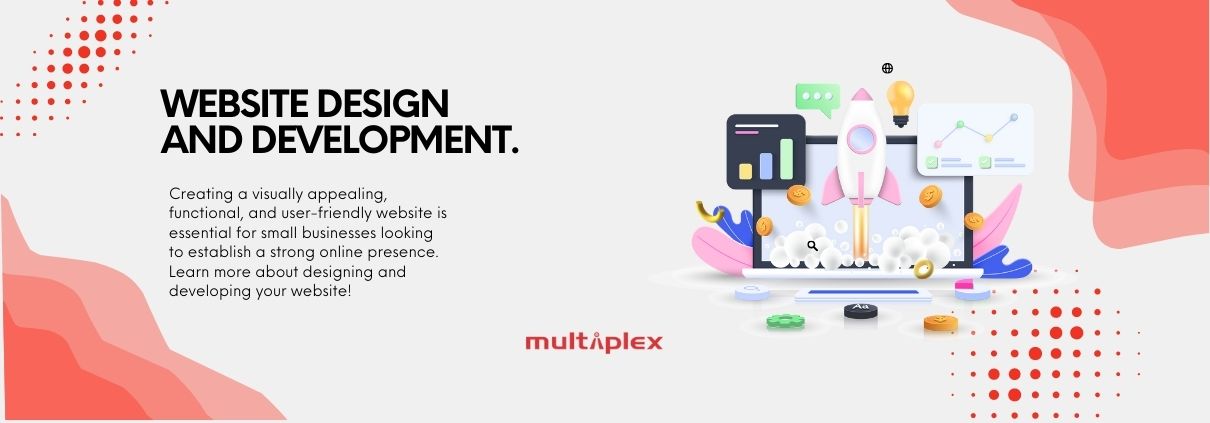Website design and development
Introduction:
Creating a visually appealing, functional, and user-friendly website is essential for small businesses looking to establish a strong online presence. This section will explore various aspects of website design and development, providing guidance and examples to help you create a successful website.
1. Importance of Responsive Web Design
1.1 What is Responsive Web Design?
Responsive web design (RWD) is an approach to web design that ensures a website’s layout, images, and other elements automatically adjust to fit different screen sizes and devices. This approach allows for optimal viewing and interaction, whether a user is accessing the website from a desktop computer, tablet, or smartphone.
1.2 Benefits of Responsive Web Design
- Improved user experience: RWD creates a seamless browsing experience across different devices, ensuring users can easily navigate and consume content on your website.
- Higher search engine rankings: Google and other search engines prioritize mobile-friendly websites in search results, making RWD crucial for search engine optimization (SEO).
- Cost-effective: By implementing RWD, you eliminate the need for separate mobile and desktop versions of your website, saving both time and resources
“Good design is making something intelligible and memorable. Great design is making something memorable and meaningful.”Dieter Rams
2. Website Templates vs Custom Design
2.1 Website Templates
Website templates are pre-designed layouts that can be easily customized to fit your brand and content. They are typically offered by website builders or content management systems (CMS) like WordPress, Wix, or Squarespace.
Pros:
- Cost-effective: Website templates are often more affordable than custom designs, making them an attractive option for small businesses with limited budgets.
- Faster development: Templates allow you to create a functional website quickly, as the design and structure are already in place.
- Variety of options: There are thousands of templates available, catering to various industries and styles.
Cons:
- Limited customization: Templates may not offer the level of customization needed to create a unique and memorable website.
- Potential similarity: Other businesses may be using the same template, resulting in a less distinctive online presence.
2.2 Custom Website Design
Custom website design involves creating a unique website from scratch, tailored specifically to your business and target audience.
Pros:
- Unique and memorable: A custom design ensures your website stands out from competitors and creates a lasting impression on users.
- Greater control: Custom designs offer the flexibility to create a website that aligns perfectly with your brand and goals.
- Scalability: Custom designs can be more easily adapted and expanded as your business grows and evolves.
Cons:
- Higher cost: Custom website design typically requires a larger budget, as it involves more time and expertise.
- Longer development time: Creating a custom website from scratch can be a lengthy process, potentially delaying your online presence.
“The only important thing about design is how it relates to people.” – Victor Papanek
3. E-commerce Website Design for Small Businesses
3.1 Key Elements of E-commerce Website Design
Creating a successful e-commerce website requires careful consideration of several key elements:
- Product presentation: Showcase your products with high-quality images, detailed descriptions, and user-friendly navigation.
- Shopping cart and checkout process: Simplify the shopping cart and checkout process to minimize cart abandonment and increase conversions.
- Payment and shipping options: Offer a variety of payment and shipping options to cater to different customer preferences.
- Security and trust: Implement SSL certificates and other security measures to protect user data and build trust with customers.
3.2 E-commerce Platforms
Popular e-commerce platforms for small businesses include Shopify, WooCommerce (for WordPress), and BigCommerce. These platforms offer templates, tools, and features specifically designed for online stores, simplifying the design and development process.
“E-commerce is not just a platform or an isolated strategy; it is a key expression of your brand with the potential to transform your business and direct-to-consumer initiatives.” – Ben Cook
4. WordPress Website Development for Small Businesses
4.1 Benefits of WordPress for Small Businesses
WordPress is a popular CMS that offers a range of benefits for small businesses:
- Flexibility: WordPress supports various types of websites, from blogs and portfolios to e-commerce stores and corporate sites.
- Customization: With thousands of themes and plugins available, WordPress offers extensive customization options to suit your unique needs.
- User-friendly: WordPress’s intuitive interface makes it easy for non-technical users to manage and update their websites.
- SEO-friendly: WordPress is built with SEO in mind, helping your website rank higher on search engines.
4.2 WordPress Themes and Plugins
Themes: WordPress offers a vast selection of themes (both free and paid) that provide the foundation for your website’s design. When choosing a theme, consider factors like responsiveness, customization options, and compatibility with popular plugins.
Plugins: Plugins are add-ons that extend the functionality of your WordPress website. Popular plugins for small businesses include Yoast SEO (for search engine optimization), WooCommerce (for e-commerce), and Contact Form 7 (for creating contact forms).
“WordPress is a factory that makes webpages is a core analogy designed to clarify the functions of WordPress: it stores content and enables a user to create and publish webpages, requiring nothing beyond a domain and a hosting service.” – Matt Mullenweg
5. Mobile App Development for Small Businesses
5.1 Benefits of Mobile Apps for Small Businesses
- Enhanced customer engagement: Mobile apps offer a more interactive and personalized user experience compared to websites.
- Increased brand visibility: Having a mobile app can help boost brand recognition and keep your business top-of-mind for customers.
- Push notifications: Mobile apps allow you to send targeted push notifications, promoting special offers, updates, or reminders.
- Offline access: Unlike websites, mobile apps can be accessed even without an internet connection, offering convenience and accessibility to users.
5.2 Considerations for Mobile App Development
- Platform: Determine which platform(s) your app should be developed for, such as iOS, Android, or both.
- Budget: Mobile app development can be expensive, so it’s essential to have a clear budget in mind before starting the project.
- Features and functionality: Identify the key features and functionality you want to include in your app, prioritizing those that align with your business goals and target audience needs.
“The future of mobile is the future of online. It is how people access online content now.” – David Murphy
In conclusion, website design and development play a crucial role in the success of your small business’s online presence. By focusing on responsive web design, choosing the right design approach, optimizing your website for e-commerce, leveraging WordPress, and considering mobile app development, you can create a website that effectively supports your business goals and meets the needs of your target audience.



